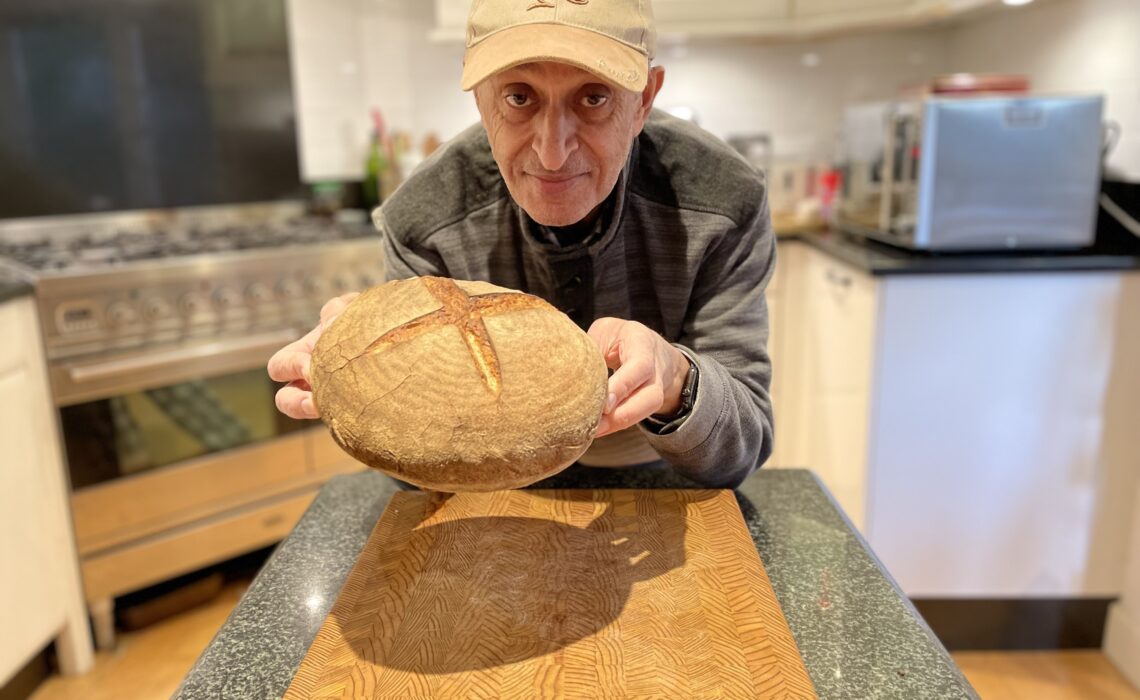
What do croissants, focaccia, ciabatta, and sourdough breads have in common? Well, for one thing, they all take a long time to make and bake, like 24 hours or even more. For another, you can practice for years, and still get them wrong more frequently than you would like. The techniques involved are more scientific than artistic and any small deviation from the science is liable to end in disaster that slowly consumes your spirit and saps your enthusiasm.
A long, long time ago, I foolishly set myself the objective of baking ‘excellent’ croissants. In those days there was no internet, much less YouTube to get tips on ingredients and techniques. I had to rely on recipe books (remember those?), and professionals who were prepared to give you the benefit of their experience. I was surprised by how generous they were with their advice, until I realised that they were confident that I had no chance of becoming a competitor anytime soon. It was like asking Leonardo Da Vinci how to paint a portrait like the Mona Lisa. Even if he gave you precise amounts of paints with mixing ratios, type of brushes he used, down to the canvas he preferred, you would still end up with a mess. Anyway, I persevered and after five years of failures, I produced something that could pass off as croissants. I declared myself a winner and NEVER made croissants again, preferring to buy ready-made ones from reputable bakeries.
More recently while living in Cyprus, someone suggested that bread had a bloating effect on certain people due to the use of yeast as the leavening / raising / fermenting agent. Having suffered from bloating for many years, I investigated this claim and this time, I deployed YouTube to help my research. Sure enough, Many You Tubers denigrated yeast and suggested sourdough starter instead. In case you don’t know, yeast is a fungus culture while sourdough is a bacterial one. They all advocated the mantra: fungus is bad, bacteria are good.
One baker on YouTube explained how to make sourdough starter, which took two weeks or so to ferment but once you created the culture, you could always top it up and use it over and over again, for weeks, months, even years. Basically, with some discipline, you can have a constant supply of sourdough starter for life and pass it on as a family heirloom to your children and grandchildren. Everything he said sounded positive and promising, except that you need to wait for two weeks or so to even begin to make your first loaf of sourdough bread. However, he said that sourdough starter is so cheap and plentiful, any local baker will be more than pleased to give you a jar of their stock for free and you save yourself two weeks of waiting.
As luck would have it, I came across two British bakers who set up an artisan bakery in Cyprus. One of my colleagues knew them well and he volunteered to get me some of their starter. The following day, he came in very embarrassed and highly apologetic saying they refused to let me have any because it was a trade secret!
The secret these two characters had was their mean-spirited, superior attitude. Sourdough starter is simplicity itself. You start with equal measures of water and ordinary flour, say 50gm. The following day, you add the same amount and on the third day, you double the amount; this process is called ‘feeding’ the starter. That’s it, there are no other secrets to the process and before you know it, you have a mixture which is full of active bacteria that create air bubbles and when added to a bread mixture it will work as a raising agent instead of yeast.
What these two patrician bakers did was to fuel a fire in me! I set myself the goal of baking a better sourdough bread than they did. This meant having to visit their shop and buy sourdough bread a few times so I can get a sense of the look, taste, texture, and after-effects of bloating. I also purchased bread from other bakeries for comparison purposes. I had to confess; their sourdough bread was very good. The bar was set high and I had to learn to jump from scratch.
This challenge I set myself started in 2017 and the first hurdle to jump was fermenting a sourdough starter culture. It took me endless further research, about five false starts and two months of effort to finally have a sourdough starter I can use.
What I found hard to come to terms with was to follow experts’ advice and throw away as much as half of the starter every few days. The reason for this bacteria murder is a practical one. If you keep doubling the amount of sourdough starter as you feed it, you will end up having to build an extension to your house or rent a large warehouse to store the alarmingly growing amounts of starter you are feeding on daily basis. This is like placing one grain of rice on the first square of a chessboard, two on the second, four on the next, all the way to the 64th square. There simply is not enough rice in the world to complete this task!
There followed a number of attempts at actually baking sourdough bread. The ingredients are simple: flour, water and salt, to which you add a certain amount of the starter based on the size of the loaf of bread you are hoping to produce. The challenges are in the kneading, folding, and shaping. If the starter is a lesson in chemistry, the kneading folding and shaping is a lesson in physics and maths. The baking is a lesson in thermal engineering science. This begs the questions: where is the art in all of this process and why do they call it ‘artisan bread’? There is some art in the kneading, folding and shaping the overall look of the end product but, the rest is just unforgiving science with very thin margin of errors.
Given that I had a day job which required me to travel a fair amount, I was only able to pursue this curse of a hobby at weekends and holidays. Nevertheless, I must have baked between 20 and 30 loaves of sourdough bread between 2017 and 2018. Sadly, I never got anywhere near as good as those two British bakers’ product, which was now annoying me more than it should have.
Then I found a perfect excuse to stop this madness; I fell ill and did not have the energy to sit up in bed, much less get up and make sourdough bread. However, I somehow conned Claire to keep feeding the starter on regular basis until I got better. She must have sensed I was serious about this topic, so she diligently fed the damned starter religiously, associating the survival of the starter with my health condition.
Healthwise, 2019 was a worse year than 2018 however, there were small windows of opportunity for me to renew my sourdough bread challenge. Surprisingly, I made quite a bit of progress and on a few occasions, came up with reasonable results that I was prepared to let others sample my creation. Although I had lots of praise for my efforts, deep down, I knew I had not reached the standard I set myself two years earlier. Being the stubborn type who never gives up, I gave up!
Instead, I focused on mastering other skills and writing (like I am doing now). The other factor was the pandemic, which recruited an entire army of sourdough bread bakers all over Europe and the USA. The field was too crowded with well-intentioned and altruistic people who wanted to master an ancient bread making technique. That for me was too high-minded and worthy objective I did not sign up for; I was doing this to prove a personal point to two adversaries who weren’t even aware of my adversarial efforts.
Finally, and after about 18 months of sourdough silence, it was Claire who suddenly decided she wanted to make sourdough bread. I said: “be my guest, I am over this obsession”. With her ‘slowly, slowly, catch you monkey’ ploy, Claire dragged me into the kitchen reluctantly and before I knew it, I was making the bread and she was cheering me on from the sides. Being the positive type, she always had something good to say about the result every time I brought out this lump of bread from the oven. I have made maybe 12 or so loaves so far and maybe three of them were to my satisfaction on look, taste, smell and texture. This is about 25% success rate, which is not commercially viable and if I were to add the cost of ingredients, energy, tools, and effort, I would have to price each loaf at about £200, instead of maybe £5.
You may be wondering how my sourdough bread compares to the two bakers’ bread in Cyprus. Well, the three that I rated as successful are in fact better than theirs. Apart from me, no one really cares, especially the two bakers who unwittingly set me off on an interesting journey of discovery.
So, where do I go from here? Well, I no longer care what these two dudes do or don’t do. Nor do I care if my bread is better than theirs because the whole consumption experience is such a subjective measure, there is no way of knowing for certain which is truly better. What Claire and I have now is a regular supply of crusty, chewy, deep taste of bread that is far superior to ordinary bread. What I wish for is a consistent result and my percentage of success to be well above 25%.
By the way, the bread loaf you see in the picture above is one of those rare successes; what, did you think I would show you one of my failures?



Well I have tasted some of your efforts and found them scrumptious! It is a good job I live far away or I would have been pestering you to teach me! Nothing better than a slice of your bread & some good olive oil for dipping!
Happy to have been part of the bread tasting committee! Xx